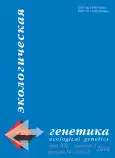Helminths infestation of various mitochondrial lines of the sable Martes Zibellina and the pine marten M. MARTES
- Authors: Zhigileva O.N1, Uslamina I.M1
-
Affiliations:
- Tyumen State University
- Issue: Vol 14, No 2 (2016)
- Pages: 43-49
- Section: Articles
- URL: https://journals.rcsi.science/ecolgenet/article/view/3601
- DOI: https://doi.org/10.17816/ecogen14243-49
- ID: 3601
Cite item
Full Text
Abstract
Full Text
##article.viewOnOriginalSite##About the authors
Oxana N Zhigileva
Tyumen State University
Email: zhigileva@mail.ru
associate professor, Ph.D, Department of Ecology and Genetics
Inna M Uslamina
Tyumen State University
Email: inna_golovacheva@mail.ru
postgraduate, Department of Ecology and Genetics
References
- Гашев С.Н., Агешин Н.Н. К вопросу о дифференциации представителей рода Martes Тюменской области // Вестник Тюменского государственного университета. - 2003. - № 2. - С. 15-21. [Gashev SN, Ageshin NN. K voprosu o differentsiatsii predstaviteley roda Martes Tyumenskoy oblasti. Vestnik Tyumenskogo gosudarstvennogo universiteta. 2003;2:15-21. (In Russ).]
- Граков Н.Н. Филяроидоз и скрябингилез лесной куницы и их влияние на состояние популяции этого вида // Труды ВНИИ животного сырья и пушнины. - 1962. - Т. 19. - С. 298-314. [Grakov NN. Filaroidos i skrjabingilos lesnoy kunitsi i ikh vlijanie na sostoyanie populatsii etogo vida. Trudy VNII zhivotnogo syrja i pushniny. 1962;19:298-314. (In Russ).]
- Козлов Д.П. Определитель гельминтов хищных млекопитающих СССР. - М.: Наука, 1977. - 274 с. [Kozlov DP. Opredelitel’ gel’mintov hishhnyh mlekopitajushhih SSSR. M.: Nauka; 1977. (In Russ).]
- Контримавичус В.Л. Гельминтофауна куньих и пути ее формирования. - М.: Наука, 1969. - 386 с. [Kontrimavichus VL. Gel’mintofauna kun’ih i puti ee formirovania. M.: Nauka; 1969. (In Russ).]
- Павлинин В.Н. Отношения между близкими видами млекопитающих в районах соприкосновения их ареалов (на примере отношений куницы и соболя на Урале): Автореф. дис. … д-ра биол. наук. - Свердловск, 1964. - 42 с. [Pavlinin VN. Otnoshenia mezhdu blizkimi vidami mlekopitajushih v raionah soprikosnovenia ih arealov (na primere otnoshenij kunitsy i sobolja na Urale [dissertation]. Sverdlovsk; 1964. (In Russ).]
- Усламина И.М., Жигилева О.Н. Морфология и экологические особенности соболя Martes zibellina, обитающего на территории Тюменской области // Фундаментальные и прикладные аспекты современной биологии: материалы II Всероссийской молодежной научной конференции, Томск, 24-26 ноября 2015 г. - Томск: Издательский дом Томского государственного университета, 2015. - C. 120-122. [Uslamina IM, Zhigileva ON. Morphologia and ecologicheskie osobennosti sobolja Martes zibellina, obitajusthego na territorii Tyumenskoy oblasti. In: D.S. Vorob’ev, editor. Fundamentalnye i prikladnye aspecty sovremennoi biologii [conference proceeding]. Tomsk; 2015:120-122. (In Russ).]
- Abramson NI, Rodchenkova EN, Kostygov AY. Genetic variation and phylogeography of the bank vole (Clethrionomys glareolus, Arvicolinae, Rodentia) in Russia with special reference to the introgression of the mtDNA of a closely related species, red-backed vole (Cl. rutilus). Rus J Genet. 2009;45(5):533-545. doi: 10.1134/S1022795409050044.
- Balmysheva NP, Solovenchuk LL. Genetic variation of the mitochondrial DNA gene encoding cytochrome b in the Magadan population of sable Martes zibellina L. Rus J Genet. 1999;35(9):1077-1081.
- Davison A, Birks JDS, Brookes RC, et al. Mitochondrial phylogeography and population history of pine martens Martes martes compared with polecats Mustela putorius. Mol Ecol. 2001;10(10):2479-2488. doi: 10.1046/j.1365-294X.2001.01381.x.
- Koepfli KP, Deere KA, Slater GJ, et al. Multigene phylogeny of the Mustelidae: resolving relationships, tempo and biogeographic history of a mammalian adaptive radiation. BMC Biol. 2008;6(10):1-22. doi: 10.1186/1741-7007-6-10.
- Malyarchuk B, Derenko M, Denisova G. A mitogenomic phylogeny and genetic history of sable (Martes zibellina). Gene. 2014;550(1):56-67. doi: 10.1016/j.gene.2014.08.015.
- Monakhov VG. The ecological structure of sable populations in the nidus of filaroides invasion. Rus J Ecol. 1999;30(6):420-427.
- Nieberding CM, Olivieri I. Parasites: proxies for host genealogy and ecology. Trends in Ecology and Evolution. 2007;22(3):156-165. doi: 10.1016/j.tree.2006.11.012.
- Rozhnov VV, Meschersky IG, Pishchulina SL, Simakin LV. Genetic analysis of sable (Martes zibellina) and pine marten (M. martes) populations in sympatric part of distribution area in the Northern Urals. Rus J Genet. 2010;46(4):488-492. doi: 10.1134/S1022795410040150.
- Sidorovich V, Anisimova EIE. Comparative analysis or the helminthocenoses of the native semiaquatic mustelids (Lutra lutra, Mustela lutreola) in connection with the width of food spectra. IUCN Otter Spec Group Bull. 1999;16(2):76-78.
- Statistica for Windows (Computer program manual). Tulsa, OK: StatSoft, Inc., 1998.
- Zhigileva ON, Cheboksarova IB. Nematode infestation of sable and pine marten in Western Siberia. In: Seryodkin IV, Miquelle DG, editors. Diseases and parasites of wildlife in Siberia and the Russian Far East. Vladivostok: Dalnauka; 2012. P. 194-198.
- Zhigileva ON, Kashtanov SN, Golovacheva IM. Genetic markers for studying current distribution area and population structure of the sable Martes zibellina L. Achievements in the Life Sciences. 2014 a;8(1):10-15. doi: 10.1016/j.als.2014.06.004.
- Zhigileva ON, Politov DV, Golovacheva IM, Petrovicheva SV. Genetic variability of sable Martes zibellina L., pine marten M. martes L. and their hybrides in West Siberia: polymorphism of proteins and DNA. Rus J Genet. 2014b;50(5):508-517. doi: 10.1134/S1022795414050135.
Supplementary files








